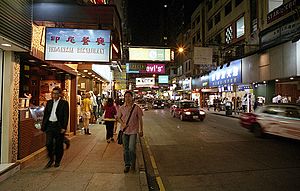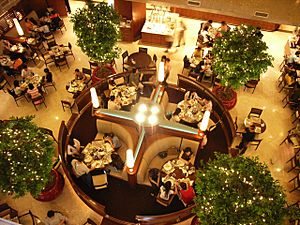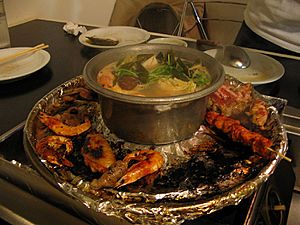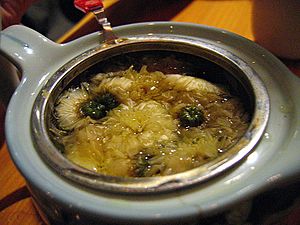Hong Kong cuisine facts for kids

Hong Kong cuisine is a mix of many different food styles. It's mostly influenced by Cantonese cuisine, which comes from a part of China close to Hong Kong. But because Hong Kong was a British colony and a busy port, its food also has flavors from European cuisine (especially British), other Chinese regions like Hakka and Shanghainese, and even Japanese, Korean, and Southeast Asian foods. This mix makes Hong Kong a "Gourmet Paradise" and a "World's Fair of Food"!
Contents
About Hong Kong Food
Hong Kong's economy is mostly about services, and restaurants are a big part of it. Hong Kong is one of the most crowded places in the world, with over 7 million people. This means there are lots of restaurants, and they compete a lot! Because the city is small, you'll find many restaurants packed into a small area.
Most people in Hong Kong are Cantonese, so Cantonese cuisine is often cooked at home. Families usually eat rice as their main food. They buy ingredients from local shops or supermarkets, which are becoming more popular.
Homes and kitchens in Hong Kong are usually small because of the high population. Traditional Chinese cooking often needs very fresh ingredients, so people shop for food often and buy smaller amounts. Also, many people are very busy with work (about 47 hours a week on average), so eating out or getting take-out food is very common.
Food History in Hong Kong
Early Days: Colonial Times
Hong Kong's food story began when it became a British colony in 1841. Soon, many Western business people and Chinese people from nearby Canton came to Hong Kong for trade. At first, there were wealthy Westerners, Chinese workers, farmers, and fishermen. The simple food of the local people was very basic compared to the fancy food in Canton.
As Hong Kong grew, there was a need for meals to entertain business guests. Some Chinese restaurants opened in the late 1800s and early 1900s. These were often branches of famous restaurants from Canton. They offered big banquets with many dishes. These fancy meals were very expensive, costing as much as a clerk's monthly pay! Most Chinese people couldn't afford to eat at restaurants. They ate simple country food at home. Meat was usually only for special days. Western restaurants were separate and served fancy European meals.
1920s: Canton's Influence
For a long time, Hong Kong's food was not as famous as Canton's. Many Hong Kong chefs learned their skills in Canton. People used to say, "The food is in Canton" (食在廣州). Cantonese food in Canton was at its best in the 1920s, known for careful cooking even for simple dishes like Char siu (BBQ pork) or congee (rice porridge). Very expensive dishes, like braised shark fin soup, were also famous. Eventually, this amazing cooking style came to Hong Kong.
1949: New Flavors Arrive
In 1949, the Chinese Civil War ended, and many people moved to Hong Kong to escape. A lot of these refugees were from parts of China where they didn't speak Cantonese, like the area around Shanghai. They brought Shanghai cuisine to Hong Kong. Also, many famous chefs from Canton moved to Hong Kong to avoid the new government in mainland China.
To keep their businesses going, many restaurants started offering yum cha (tea and dim sum) and wedding banquets. At the same time, Chinese people in Hong Kong became more interested in Western food.
Soon, Egg tarts and Hong Kong-style milk tea became popular parts of Hong Kong's food culture. Many people believe that Hong Kong's modern food scene really started to take shape after 1949.
1960s–1980s: Good Times for Food
By the 1960s, Hong Kong's economy was doing much better. It was a calm and open place compared to mainland China. Cantonese food in Hong Kong even became better than in Guangzhou, which had seen a decline. As people became wealthier from the mid-1960s, they wanted better food. Many chefs, who had learned their skills before 1949, started making the best fine dining dishes from Guangzhou and Shanghai. Families began celebrating special occasions at restaurants instead of at home. Seafood became a special treat in the 1960s, followed by game meat in the 1970s.
This time of wealth also made Hong Kong people more aware of foreign foods. They started trying new ingredients like asparagus and crayfish from Australia. Food styles from Japan and Southeast Asia also began to influence local food. This led to "nouvelle Cantonese cuisine" (Chinese: 新派粵菜), which mixed foreign dishes like sashimi into Cantonese banquets. For the first time, many Hong Kong Chinese could afford to eat at fancy Western restaurants, which used to be only for wealthy Westerners.
1980s-1990s: Connecting with China and Taiwan
When China started to open up its economy, Hong Kong chefs could reconnect with chefs from mainland China. This helped them learn about different regional Chinese foods, which also added to the new Cantonese cuisine in Hong Kong. When martial law in Taiwan ended in 1987, it led to more Taiwanese cuisine restaurants in Hong Kong. Taiwanese tourists and business people often stopped in Hong Kong on their way to mainland China.
From 1978 to 1997, Hong Kong was seen as the world's center for Chinese food, not just Cantonese. Restaurants in mainland China, Taiwan, and other Chinese communities around the world wanted to hire chefs trained in Hong Kong. They also copied dishes that were improved or created there. "Hong Kong-style Cantonese cuisine" (Chinese: 港式粵菜) became famous for being new and creative. There was even a rumor that the Chinese government secretly asked a top chef from Hong Kong to teach chefs in Beijing how to make good Peking duck in the early 1980s, as the skills had been lost during the Cultural Revolution.
After 1997: New Challenges
After Hong Kong was returned to China in 1997, there was an Asian financial crisis and the SARS epidemic. This caused a tough time for restaurants, and many famous ones closed. Some people say that as people in coastal China became richer, the demand for expensive foods like abalone and grouper went up. This made many celebratory dishes too expensive for even many middle-class families in Hong Kong.
At the same time, Hong Kong people's tastes became more global. They started to appreciate specific European foods instead of just "Western cuisine." They also liked Japanese cuisine and Thai cuisine more and more. This led to many new restaurants specializing in different ethnic foods for young couples, while fine-dining Cantonese restaurants became fewer.
In the early 2000s, some people felt that Hong Kong's food culture was not as strong as it used to be. They said that fewer new dishes were being invented compared to the 1980s. Also, it became harder to train new Chinese chefs in the traditional long apprenticeship style. However, some hopeful people believe Hong Kong can still develop a great "foodie" culture and keep its best traditional cooking alive.
Historically, Hong Kong got its food from small shops like rice dealers, wine shops, and convenient stores that sold fresh bread. Wet markets (Chinese: 街市), where people could buy fresh produce and meat, were also very important. One of the first markets was Central Market, Hong Kong, started in the 1840s.
The idea of one big store, a supermarket, that sold all food items didn't become common until the early 1970s. Air-conditioned supermarkets became standard in the 1980s.
Eating Habits
Most restaurant serving sizes in Hong Kong are quite small compared to countries like the United States or Canada. The main course usually comes with a good amount of rice or noodles. People in Hong Kong generally eat about 5 times a day.
Common Ingredients
Just like other Cantonese food, Hong Kong cooking uses many different ingredients. Here are some common ones:
|
|
Chinese and Other Asian Food Styles
Street Food (Hawker)

These are food stalls on the street, often run by one or two people pushing a cart. These carts can move around, letting sellers find the busiest spots. They were very popular in the 1970s and 1980s. However, strict health rules have made it harder for these mobile food businesses to operate.
Popular street foods include:
- Fish balls
- Put chai ko (a sweet steamed cake)
- Egg waffles
- Roasted chestnuts
Cantonese Cuisine
Since Cantonese people are the largest group in Hong Kong, Cantonese food is the main style for home cooking and eating out. Many early famous Cantonese restaurants in Hong Kong were branches of well-known restaurants from Guangzhou. Most chefs in Hong Kong learned their skills in Guangzhou until the 1970s. Many famous Hong Kong dishes came from Guangzhou and were then made even better for international tastes. Cantonese food can be very cheap, like lou mei (braised meats), or very expensive, like abalone dishes.
One very special part of Cantonese cuisine is dim sum. Waiters push carts with stacks of steamer baskets or small plates of food for customers to choose from. Dim sum includes dishes with meat, seafood, vegetables, and even desserts and fruit. The phrase yum cha (meaning "drink tea") is often used for eating dim sum in Hong Kong. Families often go for dim sum on weekends.
Some Cantonese dishes:
- Cart noodles
- Siu mei (roasted meats like BBQ pork)
- Cha siu baau (BBQ pork buns)
- Shaomai (pork and shrimp dumplings)
- Har gau (shrimp dumplings)
- Steamed meatballs
- Lo mai gai (sticky rice in lotus leaf)
- Fun guo (dumplings with various fillings)
- Tofu skin rolls
- Spring rolls
- Rice noodle rolls
- Crispy fried chicken
- Seafood birdsnest
- Pork knuckles and ginger stew
Hot Pot
This cooking style, called daa bin lou (Chinese: 打邊爐) in Cantonese, is unique because everyone at the table is a chef! A pot of boiling soup is placed in the middle of the table. You choose your favorite soup flavor. Then, everyone cooks their own ingredients in that pot. This is very popular, especially in winter, as people gather around the warm pot. It's also a fun way to eat together.
Common hot pot ingredients:
- Beef, pork, chicken
- Crab, prawns, and clams
- Chinese cabbage, carrots, and lettuce
- Fish balls and beef balls
- Tofu
Hong Kong-Style Drinks
Non-alcoholic beverages are very popular at Cha chaan teng, which are special Hong Kong-style cafes. Since drink recipes are not fixed, the taste can be different at each restaurant. Rock sugar and syrup are often used to make drinks sweet.
Some drinks from Taiwan, like bubble tea and honey green tea, have also become popular in Hong Kong.
Popular Hong Kong drinks:
Chinese Tea
Many different types of tea leaves are used for Chinese tea. In the 1950s and 1960s, people would go to tea houses with their pet birds in cages. Having tea was an important break in the middle of the day. Nowadays, tea is enjoyed with any meal.
Some types of Chinese tea:
- Chrysanthemum tea
- Bolay
- 24 flavors (a herbal tea)
Western-Style Food
Hong Kong-Style Western Cuisine
This category includes dishes that come from Western countries but have been changed to suit Chinese tastes. Outside Hong Kong, it's called Hong Kong-style Western cuisine or Canto-Western cuisine. Small restaurants that serve this food are often cha chaan teng. More upscale places are called "Sai Chaan Restaurants." Restaurants that expect tourists usually have both Chinese and Western menus. Most dishes are adapted with Chinese flavors, especially Cantonese ones. For example, steak might be marinated in soy sauce and served with a soy sauce gravy and fried rice. Pasta dishes are also common.
Some Hong Kong-style Western dishes:
- Macaroni in broth with fried egg and sausage or thinly-sliced ham
- Fried chicken wings, sometimes with French fries and salad
- Swiss sauce chicken wings (chicken wings cooked in a sweet soy sauce)
- Instant noodles with sausages, fried eggs, or thinly-sliced ham
- French toast, called "Western Toast" (西多士) in Chinese
- Baked pork chop rice, with fried pork chop, fried rice, usually tomato sauce, and cheese
- Hong Kong Style Borscht Soup (made with tomatoes, but usually without beetroot or sour cream)
- Lemon tea (black tea with fresh lemon slices), served hot or cold
See also
 In Spanish: Gastronomía de Hong Kong para niños
In Spanish: Gastronomía de Hong Kong para niños






